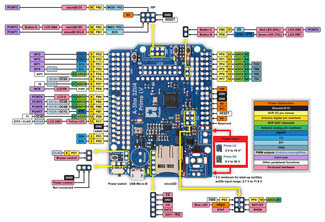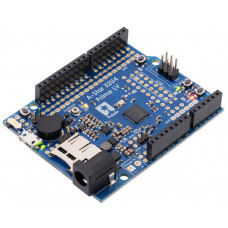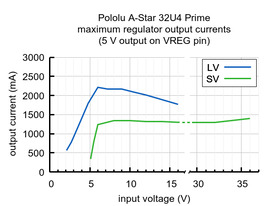A-Star 32U4 Prime LV microSD
Description
The A-Star 32U4 Prime LV is a programmable board based on the ATmega32U4 AVR microcontroller and arranged in the common Arduino form factor. The A-Star Prime offers many additional features and improvements over competing products, including superior power management that enables efficient operation from 2 V to 16 V (though it requires at least 3 V at start-up). This configuration of the A-Star 32U4 Prime LV includes microSD support and preinstalled female headers common to many Arduinos.
The Pololu A-Star 32U4 Prime is a general-purpose programmable board based on the ATmega32U4 AVR microcontroller from Microchip (formerly Atmel) and arranged in the common Arduino form factor exemplified by the Uno R3 and Leonardo. As such, the A-Star Prime (abbreviated A* Prime) is compatible with many Arduino shields, including all of the Arduino shields we carry. All 26 of the microcontroller’s GPIO lines are accessible on the board, including seven than can be used as PWM outputs and twelve that can be used as analog inputs. The ATmega32U4 is capable of native full-speed USB, which makes it more versatile than similar boards that rely on USB-to-serial adapters: in addition to supporting a virtual (CDC) serial/COM port interface, the A-Star can appear to a connected computer as a mouse and keyboard. The A-Star’s USB interface can be accessed through its USB Micro-B connector.
Our comprehensive user’s guide provides the basics you need to get started with the A-Star as well as detailed technical information for advanced users.
This product requires a USB A to Micro-B cable (not included) to connect to a computer.
 |
|
A-Star 32U4 Prime pinout diagram. |
|---|
 |
|
A-Star 32U4 Prime power distribution diagram. |
|---|
Features
- Programmable ATmega32U4 MCU with 32 KB flash, 2.5 KB SRAM, 1 KB EEPROM, and native full-speed USB (clocked by precision 16 MHz crystal oscillator)
- Preloaded with Arduino-compatible bootloader (no external programmer required)
- All 26 general-purpose I/O lines from the ATmega32U4 are broken out (including PB0, PD5, and PE2); 7 of these can be used as hardware PWM outputs and 12 of these can be used as analog inputs
- Convenient 0.1″-spaced power, ground, and signal connection points
- Buzzer option for simple sounds and music
- microSD support (microSD version only)
- HD44780-based character LCD option
- 3 user-controllable LEDs
- 3 user pushbuttons
- Reset button
- Power features:
- Can be powered from USB or from an external source (with several access points for connecting external power)
- LV operating range: 2 V to 16 V (Note: it requires an input voltage of at least 3 V to start, but it can operate down to 2 V after startup)
- SV operating range: 5 V to 36 V
- Switching 5 V regulator enables efficient operation
- 3.3 V rail supplied by 300 mA linear regulator
- Power switch for external power inputs
- Reverse-voltage protection on external power inputs
- Power selection circuit allows for seamless switching between power sources while providing overcurrent protection and feedback about which power source is selected
- Can be powered from USB or from an external source (with several access points for connecting external power)
- 6-pin ISP header for use with an external programmer
- Comprehensive user’s guide
Details for item #4008
 |
|
A-Star 32U4 Prime LV microSD. |
|---|
This configuration of the A-Star 32U4 Prime LV includes microSD support and is assembled with through-hole components as shown in the picture above so that all the basic features can be used without any additional soldering. The standard female headers common to many Arduinos are preinstalled, as is the 2×3 male ISP header, buzzer, DC power jack, and shorting block headers for enabling the microSD hardware, buzzer, and battery voltage monitor. This is the LV version of the A-Star Prime, which operates from 2 V to 16 V.
This newer version (ac03e) of the A-Star 32U4 Prime LV replaces the original version (ac03b). The new version uses an improved 5 V regulator that can deliver more current and operates from 2 V to 16 V instead of 2.7 V to 11.8 V. The easiest way to distinguish between the two versions is via the silkscreen on the bottom side of the board, above and to the left of the Pololu logo, where the original version is labeled ac03b and the new version is labeled ac03e.
A-Star 32U4 Prime LV 5 V regulator
A major feature of the A* Prime LV is its power system, which allows it to efficiently operate from a 2 V to 16 V external source. The input voltage is regulated to 5 V by a TPS630701 switching step-up/step-down (buck-boost) converter from Texas Instruments. (We also make a standalone regulator based on this integrated circuit.) The regulator’s flexibility in input voltage is especially well-suited for battery-powered applications in which the battery voltage begins above 5 V and drops below 5 V as the battery discharges. Without the typical restriction on the battery voltage staying above 5 V throughout its life, a wider range of battery types can be considered. For example:
- A 4-cell battery holder, which might have a 6 V output with fresh alkalines or a 4.0 V output with partially discharged NiMH cells, can be used to power this A*.
- A disposable 9 V battery powering the board can be discharged to under 3 V instead of cutting out at 6 V, as with typical linear or step-down regulators.
As shown in the left graph below, the LV’s 5 V switching regulator has an efficiency – defined as (Power out)/(Power in) – of 80% to 90% for most combinations of input voltage and load.
|
|
Note that the maximum available output current from the 5V pin is 1.9 A, which is limited by the power MUX. To achieve the higher output currents shown in the graphs above, you must connect to the VREG pin to bypass the power MUX and access the regulator directly.
The A-Star’s components, including the microcontroller and LEDs, draw 30 mA to 40 mA in typical applications (without the buzzer, microSD card, or an LCD). The rest of the regulator’s achievable output current, which depends on input voltage as well as ambient conditions, can be used to power other devices. The blue line in the right graph above shows output currents at which the voltage regulator’s over-temperature protection typically kicks in after a few seconds. These currents represent the limit of the regulator’s capability and cannot be sustained for long periods; under typical operating conditions, a safe limit for the maximum continuous regulator output current is 60% to 70% of the values shown in the graph.
Arduino compatibility
The A-Star 32U4 Prime ships with a preloaded Arduino-compatible bootloader (which uses 4 KB of flash memory, leaving 28 KB available for the user program). We provide a software add-on that enables the board to be easily programmed from the Arduino environment and an Arduino library to make it easy to use the additional on-board hardware. The A-Star 32U4 has the same microcontroller and form factor as the Arduino Leonardo, and it runs at the same frequency, so we generally expect it to work with shields that are compatible with the Leonardo and similar boards. Note that the Prime has additional components and connection points, so you should make sure these do not physically interfere with any shield you are considering using.
Dimensions
| Size: | 2.8″ × 2.1″ (common Arduino form factor) |
|---|
General specifications
| Processor: | ATmega32U4 @ 16 MHz |
|---|---|
| RAM size: | 2560 bytes |
| Program memory size: | 32 Kbytes1 |
| Motor channels: | 0 |
| User I/O lines: | 26 |
| Input voltage range: | 2 V to 16 V (LV) |
| Minimum operating voltage: | 2 V2 |
| Maximum operating voltage: | 16 V |
| Maximum output current: | 1.8 A3 |
| Logic voltage: | 5 V |
| Reverse voltage protection?: | Y |
| External programmer required?: | N |
| Version: | includes microSD support and preinstalled female headers |
Notes:
- 1. Note that 4 KB of the MCU's 32 KB of flash memory is used by the pre-installed USB bootloader. All 32 KB is available when programming via the ISP header rather than the bootloader.
- 2. The minimum startup voltage is 3 V, but the regulator can operate down to 2 V after startup.
- 3. Available current depends on input voltage, current consumed by the board, ambient conditions, and regulator topology. See product documentation and performance graphs for details.
Enter the code in the box below:








